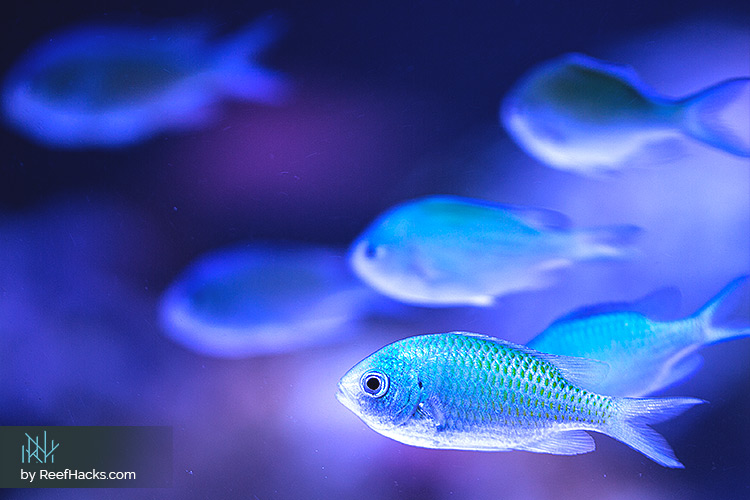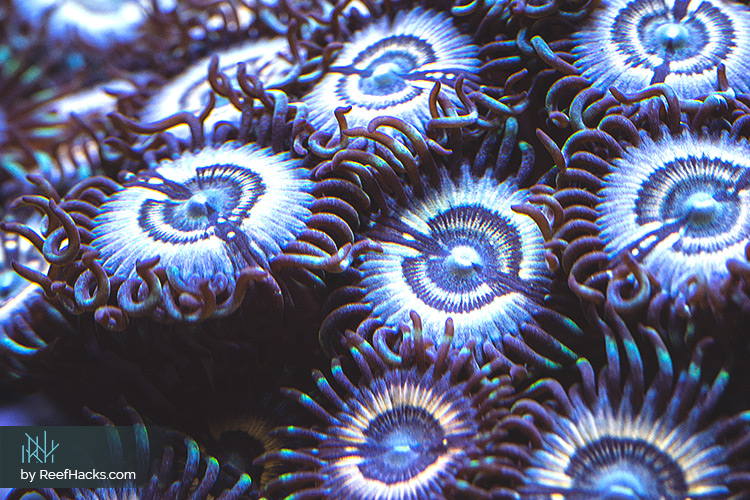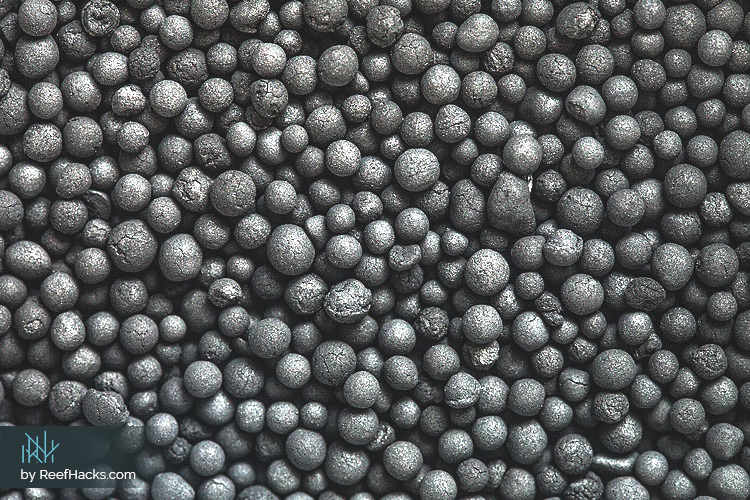Keep Your Saltwater Reef Tank Happy and Healthy With Carbon Media.
Oh, saltwater reef aquariums. When I began my journey into this underwater world, I never anticipated this hobby could transform into a multifaceted obsession. If you’re like me, as soon as you think you’ve learned it all, there’s another layer waiting to be explored.
Diving into the watery world of saltwater reef tanks is as exciting as it can be complicated. Thankfully, once you’ve covered the essentials, it gets easier.
Perhaps one of the most overlooked topics is carbon media. No, this isn’t a new TV network. You’ve likely already become familiar with this essential tank component. Have you ever heard of activated charcoal? If so, then you’re one step ahead of the game.
So what’s the big deal about carbon media? Essentially, everything!

Author:
As a lifelong aquarist, Yuliya has an endless curiosity about our underwater universe. After graduating with a bachelor’s in Environmental Engineering, she transformed her passion into a successful career. While working at the Institute of Environmental Protection in Moscow, her passion for saltwater and reef aquariums only increased. Moving to the United States in 2013, Yuliya embarked on another impactful journey by sharing her unprecedented experience for all aquarium hobbyists ... Read More.
At the heart of your saltwater reef tank, carbon media is responsible for keeping your beloved underwater universe sparkling clean. Of course, this is a diluted explanation. Whether you’re looking for advice on keeping your reef tank clean, or want to learn more about the role of carbon media, you’ve come to the right place!
Get your scuba gear ready! We’re about to dive into the depths of knowledge. Ready, set, dive!
What Is Carbon Media?
Without a doubt, carbon media is one of the most popular maintenance product in the aquarium marketplace. But have you ever wondered why? Like so many maintenance techniques, many novice aquarists simply believe it’s important because of its popularity.
To understand carbon media, and its role in the health of your saltwater reef tank, it’s important to remember your tank isn’t the ocean. I know, it’s an obvious statement. However, I’ve found many aquarists forget your saltwater reef tank is its own unique ecosystem. While it looks similar to the ocean, its operation and functionality is wholly unique. Therefore, to keep it clean and healthy, we must utilize tools not specifically utilized in the wild. In this case, carbon media.
The primary function of carbon media, such as activated carbon, is to eliminate metabolic waste from water. You’ve likely heard metabolic waste referred to as organics, which is a fancy term to describe the natural byproduct of marine life.
Don’t be confused. Organics aren’t the same as nitrates, ammonia or nitrites. Instead, organics refer to the vast array of compounds, such as proteins, organic acids, hormones, carbohydrates and phenols. Unlike popular belief, organics aren’t manufactured from external causes, such as food or medicines, but rather from invertebrates and fish.
This is where carbon media comes into play. To simplify, think of it as an air purifier, but underwater. While we could delve into the various intricacies of how carbon media works, let’s start at the beginning.
How Carbon Media Is Made?
Carbon media, specifically activated carbon, isn’t as mysterious as it sounds. Before becoming activated, it starts off as coal, nut shells or wood. Transforming this material into the filtration tool our aquariums rely on, the product is placed in an oven at extremely high temperatures.
Technically, carbon media is created through a biological process known as pyrolysis. Basically, when exposed to such high temperatures, decomposition is accelerated by removing oxygen molecules. Ultimately, this transformation changes its chemical and physical composition.
That sounds cool and all, but what does it mean?
In short, millions of tiny pores form on the interior and exterior of the product. This alters its surface area, which attracts organics into the carbon media. But that’s not the coolest part.
What’s really magical is the electrical charge created during pyrolysis, which is basically like an organics magnet. When you hear someone discussing activated carbon, this is what they’re referring to.
So now that you know how it’s made, why is it important? More specifically, is it safe and effective for saltwater reef tanks?

What Carbon Media Removes, And Why It’s Important.
As mentioned above, carbon media eliminates harmful compounds known as organics. As any experienced aquarist will agree, reef tanks are especially vulnerable because of the creatures that call it home.
Although fish produce organics, invertebrates and coral are little manufacturing facilities for these damaging substances. Case in point, tank slime. Nearly all slime found in reef tanks is made of organics.
Have you ever noticed when moving coral copious amounts of slime seems to come out of nowhere? The danger here is when the slime is chopped into smaller fragments through tank powerheads and filters until it dissolves into the water. Without carbon media, organics levels can skyrocket, which is never good.
This is the biggest filtration difference between reef tanks and the ocean. In the wild, organics are recycled through complex mechanisms. In your reef tank, no such recycling exists. So to keep our tanks balanced, organics must be removed.
Benefits of Running Carbon Media - How to Run Carbon in a Reef Tank.
To fully understand its benefits, we must investigate why organics are harmful in the first place.
If someone tells you all organics are deadly for your tank, laugh and walk away. However, before doing so, let them know that while only a handful of compounds pose a direct threat, high organics levels can promote oxygen-robbing bacteria known as heterotrophic bacteria.
Along with lowered oxygen levels, carbon dioxide increases. Ultimately, this negatively influences pH and ORP levels, which stimulates algae blooms and can transform water into a dingy, yellow color.
When it comes to your tank, excess organics taxes protein skimmers. If you’ve ever dealt with an under-performing protein skimmer, then you know this basically results in negligible phosphate and nitrate removal.
As if that wasn’t enough, evidence suggests high organics levels can increase the risk of coral and fish diseases. Knowing this, it’s easy to see why compounds removed by carbon should be eliminated. The introduction of carbon media is, in the opinion of master aquarists, the easiest and most effectively method to lowering organics and regaining control of your reef tank.
With all that being noted, it’s clear to see the overarching benefit of carbon media is its passive way of eliminating organics and supporting clean, healthy water composition. In my experience, I've found carbon media to be an effective filtration method capable of preventing harmful water conditions. As an aquarist, we should always think forwardly, which is a roundabout way of saying, the best treatment is prevention. Basically, carbon media may prevent certain fish and invertebrate diseases, which require potentially harsh treatments.
The best part? It's incredibly easy to install, maintain and replace.
Carbon Media and Saltwater Reef Tanks.
Within the realm of saltwater reef aquariums, there are three primary filtration types:
- Biological
- Mechanical
- Chemical
Without a doubt, biological and mechanical filtration systems are the most popular. However, chemical filtration, such as with carbon media or GFO ( you can read our GFO article here ), regularly demonstrates the greatest capabilities with the least amount of effort (that’s a win-win in my book).
Where to put carbon in sump?
Because carbon media purifies water through what’s known as the absorption principles, which transforms water pollutants into solidified compounds, it’s a powerful remedy for reef tank ecosystems. Throughout my research into determining why we should run carbon in reef tanks, I found when placed in a strong flow area it outperforms many other filtration methodologies.
But, instead of relying on my word alone, let’s explore exactly how and why carbon media is so beneficial for saltwater reef tanks.

Carbon Media Effects on Reef Tanks - A Brief Overview.
Browsing reef tank online forums, I regularly ran across the same questions wondering whether or not you can actually use carbon in reef tanks. In short, carbon media is among the most effective filtration methods to maintain healthy tank water composition.
Perhaps the greatest reason why carbon media should be used in reef tanks is because of its potent organics filtration capabilities. Because corals release a substantial concentration of organics, carbon media is an ideal match.
While countless novice and experienced aquarists attest to the cleaning power of carbon media, there’s still a widespread misconception regarding its safety. The biggest fear is the increased risk of HLLE in marine life due to the carbon media leeching organics back into the tank.
As with any filtration system, the risk of leaching is ever-present. However, bacteria colonies form along the surface of carbon media. These bacteria consume a small portion of organics while simultaneously inhibiting desorption of organics. Ultimately, the risk of redistributing organics back into your tank is so minimal that its influence is barely worth considering.
To minimize this risk, while improving its filtering capabilities, install the carbon media in a stronger flow area, or consider placing it within its own carbon reactor in a reef tank. Because carbon media can be quite dusty, make sure to thoroughly rinse it to prevent carbon particles from floating around your tank.
Common Carbon Media Myths Debunked.
Throughout my research, I’ve come across so many myths and misconceptions about activated carbon. Let’s put some of these myths to rest once and for all.
Myth:
Carbon media eliminates trace elements from your tank.
Truth: This is a commonly confused topic among reef tank aquarists. While trace elements, such as copper and iron, bind to carbon, the amount of trace elements extracted from your tank isn't high enough to warrant concern.
Word of Warning: I typically advise against adding trace elements to your tank simply because you use carbon media filtration. If you're worried, test your water and make your decision based on actual readings, and not simply because of the carbon media.
Myth: Too much carbon media will destroy water chemistry balance.
Truth: Carbon media only demonstrates an affinity for harmful organics. The natural methodology of its chemistry doesn’t negatively influence water chemistry. It doesn’t remove ammonia or nitrates from water, nor does it damage the water alkalinity or hardness.
Myth:
XYZ Product is the only best carbon for reef tank.
Truth: Unless I’m missing something, there isn’t one product to rule them all. Of course, there are some lesser-quality carbon media products, there are several excellent products on the market. As with many elements of saltwater reef aquariums, the “best carbon for reef tank” typically comes down to personal preference.
For example, I’m fond of Seachem MatrixCarbon in my saltwater reef aquariums. Out of the many products on the market, I found its spherical carbon design maximizes organics removal. If you’re worried about leaching, then this product is for you. From my own research, I found that it features the lowest phosphate leach levels out my previously favorited products. I highly recommend MatrixCarbon for both small and large saltwater reef tanks.
Myth: You have to put the carbon media in the canister filter or compartment for it to work.
Truth: False. The primary concern here is making sure the carbon media is placed in a strong flow area. Studies have found that even placing a mesh bag with activated carbon in sump removes substantial organics.
If you’re using carbon in a carbon reactor with GFO, add the carbon media to the top layer between two sponges. This keeps the carbon stationary so it won’t tumble. However, I always recommend placing the carbon media in its own carbon reactor for the best results. So how often to change carbon in reef tank? If you run carbon in reef tank continually, make sure to change the carbon media every four to six weeks.
Carbon Media for Reef Tanks - Your Best Option for Healthy, Clear Water.
Of course, there’s so much more we could talk about when it comes to carbon media. As with many technical aspects of saltwater reef aquariums, there’s literally hundreds of topics and knowledge bit. However, you’ve already taken the most important step: learning.
As always, if you have any questions, don’t hesitate to reach out. We’re always here to help in any way we can. Here’s to your happy, healthy and long-lasting reef tank!
What is carbon and Even more details on Carbon can be found here.
by Yuliya Ivanova for ReefHacks.



